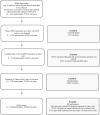A Prospective Study of Exposure to Gender-Based Violence and Risk of Sexually Transmitted Infection Acquisition in the Women's Interagency HIV Study, 1995-2018
- PMID: 32996812
- PMCID: PMC7583344
- DOI: 10.1089/jwh.2019.7972
A Prospective Study of Exposure to Gender-Based Violence and Risk of Sexually Transmitted Infection Acquisition in the Women's Interagency HIV Study, 1995-2018
Abstract
Background: Our objectives were to estimate the association of gender-based violence (GBV) experience with the risk of sexually transmitted infection (STI) acquisition in HIV-seropositive and HIV-seronegative women, to compare the STI risks associated with recent and lifetime GBV exposures, and to quantify whether these associations differ by HIV status. Methods: We conducted a multicenter, prospective cohort study in the Women's Interagency HIV Study, 1994-2018. Poisson models were fitted using generalized estimating equations to estimate the association of past 6-month GBV experience (physical, sexual, or intimate partner psychological violence) with subsequent self-reported STI diagnosis (gonorrhea, syphilis, chlamydia, pelvic inflammatory disease, or trichomoniasis). Results: Data from 2868 women who reported recent sexual activity comprised 12,069 person-years. Higher STI risk was observed among HIV-seropositive women (incidence rate [IR] 5.5 per 100 person-years) compared with HIV-seronegative women (IR 4.3 per 100 person-years). Recent GBV experience was associated with a 1.28-fold (95% confidence interval [CI] 0.99, 1.65) risk after adjustment for HIV status and relevant demographic, socioeconomic, and sexual risk variables. Other important risk factors for STI acquisition included unstable housing (adjusted incidence rate ratio [AIRR] 1.81, 95% CI 1.32-2.46), unemployment (AIRR 1.42, 95% CI 1.14-1.76), transactional sex (AIRR 2.06, 95% CI 1.52-2.80), and drug use (AIRR 1.44, 95% CI 1.19-1.75). Recent physical violence contributed the highest risk of STI acquisition among HIV-seronegative women (AIRR 2.27, 95% CI 1.18-4.35), whereas lifetime GBV experience contributed the highest risk among HIV-seropositive women (AIRR 1.59, 95% CI 1.20-2.10). Conclusions: GBV prevention remains an important public health goal with direct relevance to women's sexual health.
Keywords: HIV; intimate partner violence; physical violence; sexual violence; sexually transmitted infections.
Conflict of interest statement
No competing financial interests exist.
Figures



Similar articles
-
Physical and Sexual Violence Predictors: 20 Years of the Women's Interagency HIV Study Cohort.Am J Prev Med. 2016 Nov;51(5):731-742. doi: 10.1016/j.amepre.2016.07.005. Epub 2016 Aug 29. Am J Prev Med. 2016. PMID: 27595175 Free PMC article.
-
Patterns of Gender-Based Violence and Associations with Mental Health and HIV Risk Behavior Among Female Sex Workers in Mombasa, Kenya: A Latent Class Analysis.AIDS Behav. 2018 Oct;22(10):3273-3286. doi: 10.1007/s10461-018-2107-4. AIDS Behav. 2018. PMID: 29603110 Free PMC article.
-
Factors associated with past year physical and sexual intimate partner violence against women in Zimbabwe: results from a national cluster-based cross-sectional survey.Glob Health Action. 2018;11(sup3):1625594. doi: 10.1080/16549716.2019.1625594. Glob Health Action. 2018. PMID: 31232228 Free PMC article.
-
Sexually Transmitted Infection Prevalence among Homeless Adults in the United States: A Systematic Literature Review.Sex Transm Dis. 2018 Jul;45(7):494-504. doi: 10.1097/OLQ.0000000000000780. Sex Transm Dis. 2018. PMID: 29465661 Free PMC article.
-
Gender-based violence among female youths in educational institutions of Sub-Saharan Africa: a systematic review and meta-analysis.Syst Rev. 2019 Feb 25;8(1):59. doi: 10.1186/s13643-019-0969-9. Syst Rev. 2019. PMID: 30803436 Free PMC article.
Cited by
-
A systematic review of the association between history of sexually transmitted infections and subsequent condom use in adolescents.BMC Public Health. 2024 Apr 10;24(1):1000. doi: 10.1186/s12889-024-18322-2. BMC Public Health. 2024. PMID: 38600483 Free PMC article.
References
-
- Heise L, Ellsberg M, Gottmoeller M. A global overview of gender-based violence. Int J Gynecol Obstet 2002;78:S5–S14 - PubMed
-
- Jewkes RK, Dunkle K, Nduna M, Shai N. Intimate partner violence, relationship power inequity, and incidence of HIV infection in young women in South Africa: A cohort study. Lancet 2010;376:41–48 - PubMed
-
- Weiss HA, Patel V, West B, Peeling RW, Kirkwood BR, Mabey D. Spousal sexual violence and poverty are risk factors for sexually transmitted infections in women: A longitudinal study of women in Goa, India. Sex Transm Infect 2008;84:133–139 - PubMed
-
- Johnson PJ, Hellerstedt WL. Current or past physical or sexual abuse as a risk marker for sexually transmitted disease in pregnant women. Perspect Sex Reprod Health 2002;34:62–67 - PubMed
-
- Rahman M, Nakamura K, Seino K, Kizuki M. Intimate partner violence and symptoms of sexually transmitted infections: Are the women from low socio-economic strata in Bangladesh at increased risk. Int J Behav Med 2014;21:348–357 - PubMed
Publication types
MeSH terms
Grants and funding
- U01 HL146241/HL/NHLBI NIH HHS/United States
- U01 HL146333/HL/NHLBI NIH HHS/United States
- P30 AI050410/AI/NIAID NIH HHS/United States
- U01 HL146245/HL/NHLBI NIH HHS/United States
- U01 HL146205/HL/NHLBI NIH HHS/United States
- U01 HL146208/HL/NHLBI NIH HHS/United States
- U01 HL146192/HL/NHLBI NIH HHS/United States
- U01 HL146242/HL/NHLBI NIH HHS/United States
- KL2 TR001432/TR/NCATS NIH HHS/United States
- U01 HL146201/HL/NHLBI NIH HHS/United States
- U01 HL146193/HL/NHLBI NIH HHS/United States
- K23 HD078153/HD/NICHD NIH HHS/United States
- P30 AI050409/AI/NIAID NIH HHS/United States
- U01 HL146240/HL/NHLBI NIH HHS/United States
- UL1 TR000004/TR/NCATS NIH HHS/United States
- U01 HL146194/HL/NHLBI NIH HHS/United States
- U01 HL146203/HL/NHLBI NIH HHS/United States
- P30 AI073961/AI/NIAID NIH HHS/United States
- P30 AI027767/AI/NIAID NIH HHS/United States
- U01 HL146204/HL/NHLBI NIH HHS/United States
- U01 HL146202/HL/NHLBI NIH HHS/United States
LinkOut - more resources
Full Text Sources
Medical
Miscellaneous

